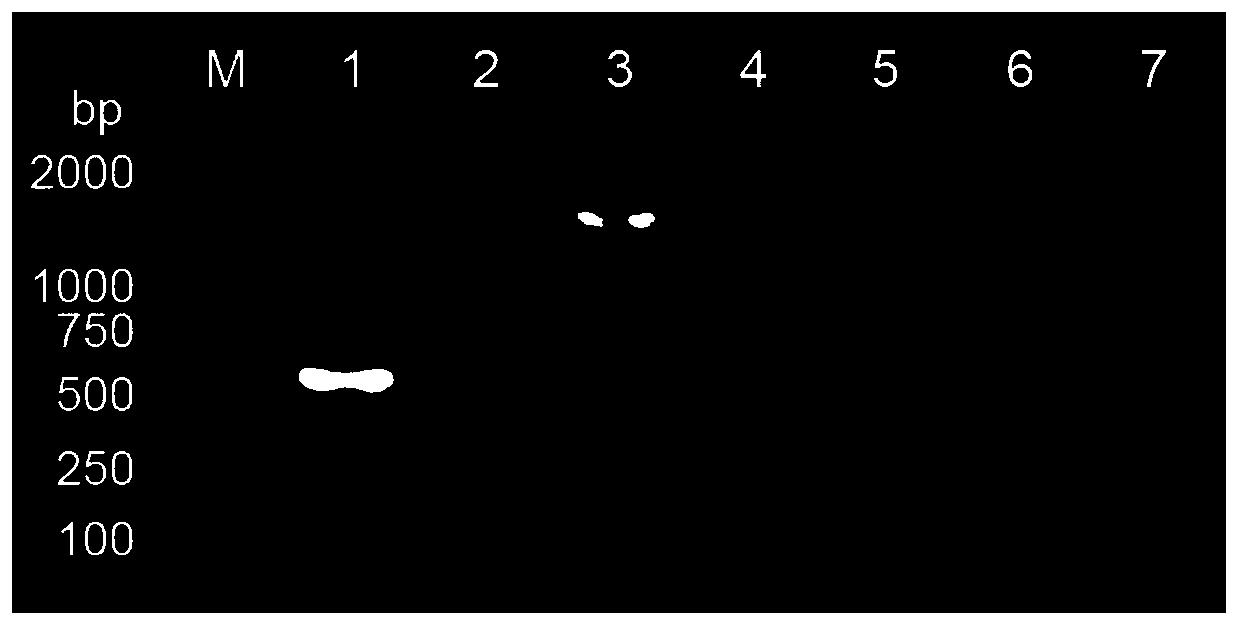Nested duplex PCR detection primer and kit for distinguishing wild strain and gene deleted strain of African Swine Fever Virus (ASFV)
A technology for African swine fever virus and gene deletion, which is applied in the field of virus strain identification, can solve the problems of unfavorable rapid identification, low sensitivity, and cumbersome steps, and achieve the effects of reduced detection time, high sensitivity, and good repeatability
- Summary
- Abstract
- Description
- Claims
- Application Information
AI Technical Summary
Problems solved by technology
Method used
Image
Examples
Embodiment 1
[0052] Example 1 Primer Design
[0053] The inventor compared a large number of CD2V and 360-505R genes of African swine fever virus (ASFV) published in the GenBanK database of NCBI (National Center for Bioinformatics of the United States) with highly conserved and specific regions, and designed ASFV CD2V and 360-505R genes Because of the specific outer primer pair and inner primer pair, the outer primer pair was named P1, P2, P3, and P4, respectively; the inner primer pair was named P5, P6, P7, and P8, respectively. The location of the primers is attached figure 1 shown. Thus, a kind of nested PCR primer for distinguishing ASFV wild-type strain and gene-deleted strain is provided, specifically:
[0054] Outer primer set:
[0055] P1: ASFV-CD2V-F1: 5'GATAATTTCGCCACCGCACTAG 3', as shown in SEQ ID NO: 1;
[0056] P2: ASFV-CD2V-R1: 5'CTGTGGGCCTCATTTTTCGTT 3', as shown in SEQ ID NO: 2;
[0057] P3:ASFV-360-505R-F1: 5'TCATTTAGAGAAGGTCATCATAGGAGC 3', as shown in SEQ ID NO:3;
...
Embodiment 2 3
[0068] Embodiment 2 Triple PCR detection method
[0069] Materials and Methods
[0070] 1.1 Primers in Example 1
[0071] 1.2 Sample DNA extraction
[0072] There are no special requirements for DNA extraction, which can be extracted according to conventional methods or DNA extraction kits. The extracted DNA was stored at -20°C for later use or immediately used for PCR amplification.
[0073] 1.3 Positive plasmid
[0074] The full-length ASFV CD2V and 360-505R genes published in the GenBanK database plus the partial sequences on both sides were artificially synthesized, connected to the pUC57 vector, transformed into E. On the LB medium plate of mycin, culture at 37°C for 12-16h. After the bacteria were picked, screened and identified by sequencing, the plasmids were extracted after expanding the culture of positive bacteria. The positive plasmids were named pUC57-CD2V and pUC57-360-505R respectively.
[0075] After manual comparison of the published ASFV CD2V gene and th...
Embodiment 3
[0088] Embodiment 3 specificity test
[0089] According to the nested double PCR detection method established in 1.4 of Example 2, pair 1: wild strain without gene deletion; 2: deletion of CD2V and 360-505R strain; 3: mixture of deletion of CD2V and 360-505R strain and wild strain ; 4: positive plasmid (CD2V); 5: negative control (deionized water); 6: classical swine fever virus (CSFV); 7: porcine pseudorabies virus (PRV); 8: porcine reproductive and respiratory syndrome virus (PRRSV ); 9: porcine parvovirus (PPV); 10: porcine encephalitis virus (JEV); 11: rotavirus (RV); 12: porcine epidemic diarrhea virus (PEDV); 13: porcine deltacoronavirus (PDCoV); 14: Porcine circovirus Ⅱ (PCV2) was detected. The results are attached image 3 shown.
[0090] From attached image 3 As can be seen in the figure, corresponding to 1: wild strain without gene deletion; 2: deletion of CD2V and 360-505R strain; 3: mixture of deletion of CD2V and 360-505R strain and wild strain; 4: lane of po...
PUM
| Property | Measurement | Unit |
|---|---|---|
| diameter | aaaaa | aaaaa |
Abstract
Description
Claims
Application Information
 Login to View More
Login to View More - R&D Engineer
- R&D Manager
- IP Professional
- Industry Leading Data Capabilities
- Powerful AI technology
- Patent DNA Extraction
Browse by: Latest US Patents, China's latest patents, Technical Efficacy Thesaurus, Application Domain, Technology Topic, Popular Technical Reports.
© 2024 PatSnap. All rights reserved.Legal|Privacy policy|Modern Slavery Act Transparency Statement|Sitemap|About US| Contact US: help@patsnap.com










